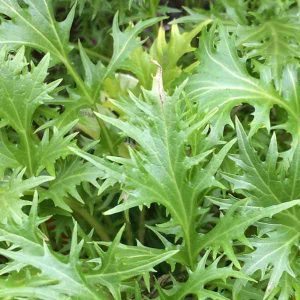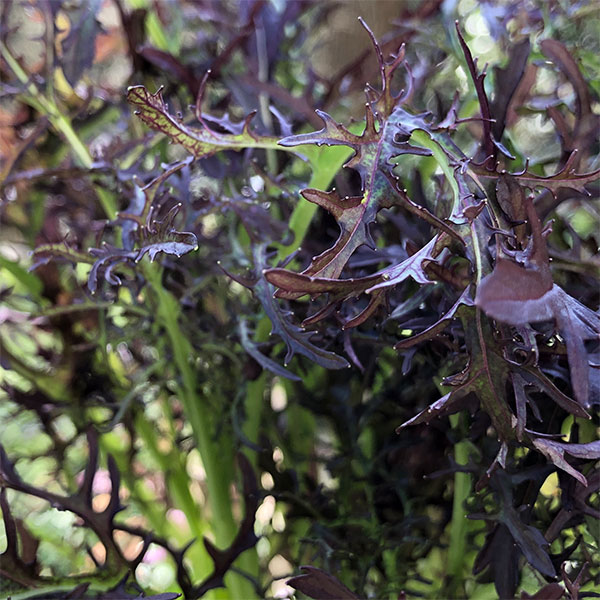
Japanese Mustard Greens
Easy to grow almost year round Mizuna, is commonly called Japanese mustard greens. Also known as Shui Cai and Kyona it is grown for the feathery leaves which are used in salads and stir fries.
It is another cool season Japanese mustard green, and as with many of these leafy greens a number of different varieties with different taste profiles are available.
How do you use Mizuna ?
Usually the young leaves are picked and added to salads. Older leaves and the stalks can be used in a stir fry. You can add it to pesto for a bit on tang. It is traditionally pickled and used as an appetiser.

Available in green and and also in a red/purple form it has a spicy tangy taste and the simplest recipes include adding a good handful that has been chopped and wilted in a little soy or teriyaki sauce to a bowl of rice. Add some garlic, sesame oil and a little shredded roast chicken, beef or fish and you have a meal.
Try tossing them in with potato salad or add them to an omelet.
How to grow Mizuna
- You can start Mizuna from seed or seedlings. It does require a rich moist soil, however it can be planted close together. From seed to first harvest will take around 8 weeks.
- Seeds can be sown directly, if growing from seedlings, be careful not to disturb the roots when transplanting.
- The best time to plant it is in autumn, and then grow it through until late spring/early summer.
- We suggest watering with a liquid seaweed fertiliser every two weeks. Make sure that the soil does not dry out, although this is not much of a problem in winter to spring.
- You can grow it in containers.
- Pick off any dead foliage to prevent disease.
- Harvest as required, young leaves are best for salads.
- At the end of the season, remove the plants and compost them.
Top Tips
- In cooler parts of the year grow in full sun, in hot climates or summer grow in part shade.
- Seeds or plants should be spaced at around 20 cm (8 inches) apart if you intend to use this as a cut and come again crop. You can also plant much closer if you are growing it was a micro green.
- In courtyards or on balconies grow Mizuna in containers perhaps in a mixed planting with other greens.
- In the garden, plant it between taller growing vegetables or on the shady side of plants such as tomatoes.
- Always harvest when the leaves are relatively small, say around 5 inches (12 cm) after this they can become a little coarse for eating raw. Larger leaves are best suited for use in stir fries. For cut and come again, snip all the leaves of the plant just a little above soil level.
To Buy Mizuna, try the following nurseries
KALLINYALLA NURSERY – Phone: 0428822725.
Shaen St Port Lincoln, SA, 5606
KLEMZIG GARDEN CENTRE – Phone: 08 8369 0338
32 O G Rd Klemzig, SA, 5087
In Victoria try
MT EVELYN GARDEN CENTRE - Phone: (03) 9736 1162
126 York Rd, Mount Evelyn VIC 3796
Excellent range of herbs and vegetables, full range of general nursery lines, pots and garden statues
AJS BULLOCK NURSERY – Phone: 03 9890 3162
48 Cosier Dr Noble Park, VIC, 3174
ACORN NURSERY – Phone: 03 5141 1900 673
Canterbury Rd Surrey Hills, VIC, 3127
AUSSIE GOLD PLANT NURSERY – Phone: 03 5428 7929
126 Amess Rd Riddells Creek, VIC, 3431
In New South Wales
Try BERRIMA COTTAGE NURSERY – Phone: 02 4877 2929
28 Old Hume Hwy Berrima, NSW, 2577
BALCONY IN BLOOM – Phone: 02 9905 2462
10 Green St Brookvale, NSW, 2100
ANNANDALE GARDEN CENTRE – Phone: 02 9660 0874
36 Booth St Annandale, NSW, 2038
BONNYRIGG GARDEN CENTRE – Phone: 02 9610
5366 Elizabeth Dr Bonnyrigg Heights, NSW, 2177
